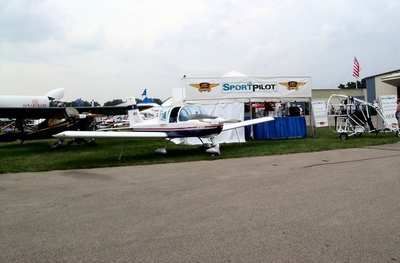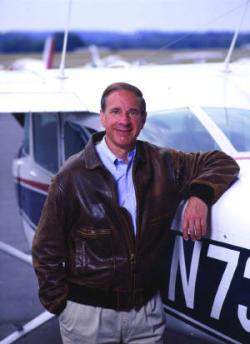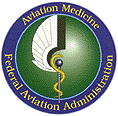Also Seeks Drivers License Medical For Rec Pilots
 The Aircraft Owners and
Pilots Association has formally asked the FAA to reconsider a
"Catch-22" situation in the current sport pilot regulations, by
allowing those pilots who have had their FAA medicals denied to be
allowed to operate light sport planes with an easily obtainable
health statement from a physician.
The Aircraft Owners and
Pilots Association has formally asked the FAA to reconsider a
"Catch-22" situation in the current sport pilot regulations, by
allowing those pilots who have had their FAA medicals denied to be
allowed to operate light sport planes with an easily obtainable
health statement from a physician.
If adopted, the move -- talked about in the pilot community
since the original sport pilot regulations were adopted two years
ago -- would require pilots to obtain a health statement from their
personal physician, declaring that he or she is healthy enough to
operate a moving vehicle and is not likely to suffer any kind of
incapacitation within the next 24 months.
Like a medical certificate, the health statement would need to
be readily accessible to the pilot when operating an aircraft.
"This simple change would eliminate the double standard that
unfairly penalized pilots who for one reason or another have
unfavorable medical records on file with the FAA but otherwise meet
the sport pilot requirements," said AOPA President Phil Boyer.

Under current regulations, a pilot who has previously been
denied a medical certificate cannot exercise sport pilot privileges
without regaining a medical certificate.
However -- in a loophole large enough to fly a Ercoupe through
-- another pilot with the same medical condition who just allowed
his medical to lapse can still fly as a sport pilot, as long as he
has a current driver's license and self-certifies that he is
healthy enough to fly.
Recreational Pilots Not Forgotten
The much-bandied "drivers license medical" is also at the heart
of a second proposal AOPA is making to the FAA, to give
recreational pilots the option of flying their larger aircraft with
only a driver's license.
 "That would mean that
even if you've lost your medical, you could still fly something as
large as a Cessna 172 if you're healthy enough for a driver's
license and don't have any medical conditions that could
incapacitate you," said Boyer (right).
"That would mean that
even if you've lost your medical, you could still fly something as
large as a Cessna 172 if you're healthy enough for a driver's
license and don't have any medical conditions that could
incapacitate you," said Boyer (right).
Like sport pilots, recreational pilots are limited to day-VFR
flying only, in a single-engine, fixed-gear aircraft. Recreational
pilots may operate larger planes, however, with up to 180
horsepower and four seats (although, like sport pilots, the pilot
can only fly with one other passenger.)
Recreational pilots are also limited to flying outside of
controlled airspace, and within 50 nm of their home airports... so,
while long cross country trips are out, you can still fly to a
nearby airport for that $200 hamburger (price has been adjusted due
to inflated fuel prices -- Ed.)
"When we petitioned in 1978 for the FAA to create a new pilot
certificate that would reduce the cost and procedural barriers to
flight training, AOPA recommended medical self-certification, just
as glider and balloon pilots are allowed to do," said Boyer. "While
the agency accepted most of our other recommendations for the
recreational pilot certificate, the FAA still insisted on a third
class medical certificate. That really limited the attractiveness
of the recreational certificate."
AOPA has petitioned the FAA numerous times to remove the medical
certificate requirement from the recreational pilot certificate.
According to AOPA, the last few times, the agency rejected the
petition saying that the issue was being considered under the sport
pilot initiative. The FAA wanted time to see what happened with
sport pilots flying without a medical certificate.
"It's now been two years and no accident history to suggest any
problem with sport pilots flying without having gone through an
FAA-approved medical examination," said Boyer. "And that just
reaffirms all the reams of data we've submitted through the
years.
 "Medical conditions are
not a significant cause of accidents in aircraft used for sport and
recreational purposes," Boyer said. "Even the FAA conceded that in
its rulemaking for the sport pilot certificate."
"Medical conditions are
not a significant cause of accidents in aircraft used for sport and
recreational purposes," Boyer said. "Even the FAA conceded that in
its rulemaking for the sport pilot certificate."
In fact, an AOPA Air Safety Foundation review of more than a
decade of accident data showed no difference in the percentage of
medical incapacitation accidents between pilots without medical
certificates and pilots required to carry a medical certificate.
Medical incapacitation accounts for less than 2 percent of all
accidents.
Furthermore, the Air Safety Foundation's analysis showed that
the majority of medically related aviation accidents were not
attributable to predictable conditions or conditions that could
have been revealed by an aviation medical examination.
 ANN's Daily Aero-Term (05.12.25): Execute Missed Approach
ANN's Daily Aero-Term (05.12.25): Execute Missed Approach ANN's Daily Aero-Linx (05.12.25)
ANN's Daily Aero-Linx (05.12.25) NTSB Final Report: Piper PA-36-375
NTSB Final Report: Piper PA-36-375 Airborne-NextGen 05.06.25: AF Uncrewed Fighters, Drones v Planes, Joby Crew Test
Airborne-NextGen 05.06.25: AF Uncrewed Fighters, Drones v Planes, Joby Crew Test ANN's Daily Aero-Linx (05.13.25)
ANN's Daily Aero-Linx (05.13.25)






